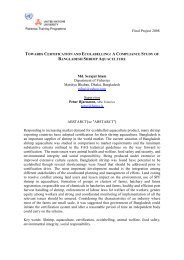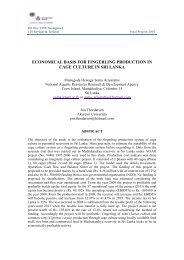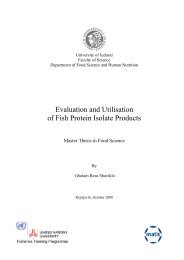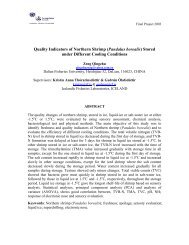Fish species abundance and distribution in The Gambia estuary
Fish species abundance and distribution in The Gambia estuary
Fish species abundance and distribution in The Gambia estuary
You also want an ePaper? Increase the reach of your titles
YUMPU automatically turns print PDFs into web optimized ePapers that Google loves.
Darboeother surveys), the zone of their overlap could be <strong>in</strong>dicative of optimum sal<strong>in</strong>econditions for many <strong>species</strong> of a wider eury-hal<strong>in</strong>ity. This is evidenced by the factthat the zone appears <strong>in</strong>termediary <strong>in</strong> terms of the number of <strong>species</strong> present.Dur<strong>in</strong>g a very reduced discharge period <strong>in</strong> June 2001, the number of <strong>species</strong>encountered <strong>in</strong> the <strong>estuary</strong> totalled about 44, more than 75% of the total number of<strong>species</strong> found throughout the five study missions (Figure 11). Among these, P.elongatus, P. notialis (PDU), Cynoglossus senegalensis (CYS), C. latimanus,Ethmalosa fimbriata <strong>and</strong> Sard<strong>in</strong>ella maderensis were encountered at almost allstations. Polydactylus quadrifilis (POQ), Pentanemous qu<strong>in</strong>quarius (PQQ) <strong>and</strong> Ilishaafricana <strong>in</strong>termittently appear throughout the study area seem<strong>in</strong>gly unrestricted by theslight lower<strong>in</strong>g of sal<strong>in</strong>ity upstream. However, <strong>species</strong> such as those of the familyAriidae tend to be restricted at the lower <strong>estuary</strong> between stations Chitabong bolong<strong>and</strong> Bal<strong>in</strong>go. Ilisha africana, a member of the family pristgastridae, also exhibitssimilar restricted <strong>distribution</strong>. Dur<strong>in</strong>g this period, all Bagridae (Chriysichtysnigrodigitatus, C. maurus etc.) were conf<strong>in</strong>ed to the mid <strong>and</strong> upper estuar<strong>in</strong>e zones. Interms of concentration, more <strong>species</strong> were observed between M<strong>and</strong><strong>in</strong>a bolong <strong>and</strong> theconfluence of B<strong>in</strong>tang bolong with the ma<strong>in</strong> <strong>estuary</strong> though very low concentrationwas observed opposite Lam<strong>in</strong> village with<strong>in</strong> this range. <strong>The</strong> high concentration atM<strong>and</strong><strong>in</strong>a bolong is attributed to the shelf-like nature of the station. Although thestation is situated at the mouth of creeks, turbidity at the station is relatively low butthe high presence of phytoplankton, feed<strong>in</strong>g E. fimbriata, S. maderensis <strong>and</strong> other<strong>species</strong> as well as an optimum daytime oxygen level (5.1 mg L-1) are <strong>in</strong>dicative of thestation hav<strong>in</strong>g high primary production.<strong>The</strong> survey conducted dur<strong>in</strong>g the ra<strong>in</strong>y season (16-25 September 2001) <strong>and</strong> a veryhigh discharge period, reduced the sal<strong>in</strong>ity level <strong>and</strong> its extent down stream wasobserved to have <strong>in</strong>fluenced the <strong>distribution</strong> of some <strong>species</strong> particularly E. fimbriata,I. africana, P. notialis, Arius latiscutatus <strong>and</strong> S. maderensis (Figures 12-14). Areal<strong>distribution</strong> of all of the above mentioned <strong>species</strong> shrank towards the lower <strong>estuary</strong>between Chitabong bolong <strong>and</strong> Tankular, although a few <strong>in</strong>dividuals of A. latiscutatuscould still be found up to Jurong po<strong>in</strong>t <strong>in</strong> the mid <strong>estuary</strong>. Aga<strong>in</strong> dur<strong>in</strong>g this periodmore <strong>species</strong> were concentrated between the Chitabong <strong>and</strong> B<strong>in</strong>tang confluence withthe exception of the deep channel stations of Banjul <strong>and</strong> Dog Isl<strong>and</strong> where <strong>species</strong>occurrence appears very scanty. <strong>The</strong> considerable depth at both stations may createse<strong>in</strong><strong>in</strong>g problems rang<strong>in</strong>g from fish escap<strong>in</strong>g from the se<strong>in</strong>e bottom to avoidance ofthe gear before encircl<strong>in</strong>g. Extensive <strong>in</strong>cursion <strong>in</strong>to the mid estuar<strong>in</strong>e zone byrelatively low sal<strong>in</strong>ity tolerant “freshwater” <strong>species</strong> was observed <strong>in</strong> Synodontisgambiensis, which was encountered downstream at up to Tabiere creek (station 10)<strong>and</strong> Schilbe <strong>in</strong>termedius at Tendaba. Despite the low sal<strong>in</strong>ity <strong>in</strong> the mid <strong>estuary</strong> dur<strong>in</strong>gthis period certa<strong>in</strong> environmentally sensitive <strong>species</strong> such as Mormyrus anguillaris(MAN) <strong>and</strong> Alestes baremose held back at the upper <strong>estuary</strong>.Sal<strong>in</strong>ity measurements dur<strong>in</strong>g the survey mission from 3-12 December 2001 <strong>in</strong>dicatea moderate discharge from the river, which had created a weakly sal<strong>in</strong>e environment<strong>in</strong> both the mid <strong>and</strong> upper <strong>estuary</strong> (Figure 4-7), with sal<strong>in</strong>ities rang<strong>in</strong>g from 0 – 5.5ppt. <strong>The</strong> weak sal<strong>in</strong>ity appears to be quite favourable to E. fimbriata, P. notialis <strong>and</strong> I.africana, all of which had exp<strong>and</strong>ed their presence <strong>in</strong> the river <strong>distribution</strong>. Thoughfew <strong>in</strong>dividuals of I. africana <strong>in</strong> particular which, dur<strong>in</strong>g the previous survey <strong>in</strong>September, restricted its <strong>distribution</strong> with<strong>in</strong> stations not above Tankular, wereUNU – <strong>Fish</strong>eries Tra<strong>in</strong><strong>in</strong>g Programme 21
















